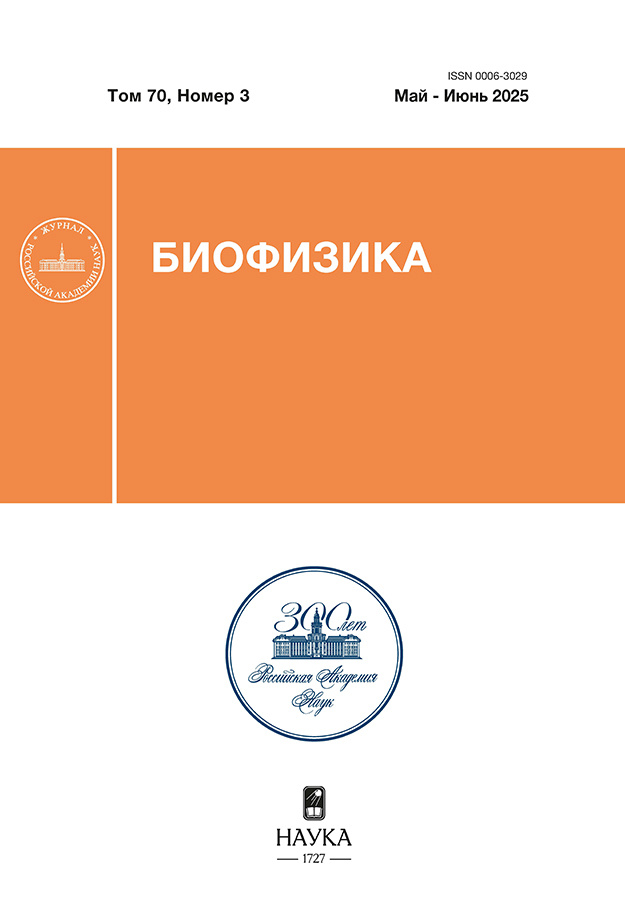Имитационное моделирование работы глутамат-цистеин лигазы
- Авторы: Копылова В.С1, Бороновский С.Е1, Нарциссов Я.Р1,2
-
Учреждения:
- НИИ цитохимии и молекулярной фармакологии
- BiDiPharma GmbH
- Выпуск: Том 68, № 2 (2023)
- Страницы: 218-229
- Раздел: Статьи
- URL: https://kld-journal.fedlab.ru/0006-3029/article/view/673544
- DOI: https://doi.org/10.31857/S0006302923020023
- EDN: https://elibrary.ru/BZOQUQ
- ID: 673544
Цитировать
Полный текст
Аннотация
Глутатион (Y-глутамил-цистеинил-глицин) - один из основных внутриклеточных антиоксидантов, играющих важную роль в клеточном обмене. В клетках млекопитающих глутатион синтезируется в две стадии, первая из которых катализируется глутамат-цистеин лигазой и является лимитирующей. В данной работе стохастический алгоритм на основе марковских цепей с непрерывным временем был использован для моделирования работы глутамат-цистеин лигазы. Было рассмотрено несколько механизмов работы, учитывающих обратное ингибирование глутатионом, а также порядок присоединения АТФ. На основании физиологических концентраций участвующих в реакции метаболитов была рассчитана скорость работы глутамат-цистеин лигазы эритроцитов человека. Среди возможных вариантов присоединения субстратов в активный центр исследуемого фермента только механизм, предусматривающий первичное связывание с АТФ, позволяет получить значение для скорости реакции, соответствующее экспериментальной измеренной активности глутамат-цисте-ин лигазы при физиологических уровнях субстратов. В случае других схем присоединения субстратов различие значений скорости составляет более порядка. Проведенный анализ позволяет сделать вывод о том, что при моделировании биосинтеза глутатиона в условиях in vivo необходимо учитывать как концентрацию молекул АТФ, так и обратное ингибирование глутатионом.
Ключевые слова
Об авторах
В. С Копылова
НИИ цитохимии и молекулярной фармакологии
Email: kopilova.veronika@yandex.ru
Москва, Россия
С. Е Бороновский
НИИ цитохимии и молекулярной фармакологииМосква, Россия
Я. Р Нарциссов
НИИ цитохимии и молекулярной фармакологии;BiDiPharma GmbHМосква, Россия;Siek, Germany
Список литературы
- A. A. Korneev, I. A. Komissarova, and Y. R. Nartsissov, Bull. Exp. Biol. Med., 116, 1089 (1993).
- В. И. Скворцова, Я. Р. Нарциссов, М. К. Бодыхов и др., Журн. неврологии и психиатрии им. С.С. Корсакова, 107, 30 (2007).
- Y. R. Nartsissov, Biochem. Soc. Trans., 45 (5), 1097 (2017).
- R. Dringen, Progr. Neurobiol. 62 (6), 649 (2000).
- Л. П. Смирнов и И. В. Суховская, Учен. зап. Петрозавод. гос. ун-та, 6 (143), 34 (2014).
- M. Deponte, Antioxid. Redox Signal., 27 (15), 1130 (2017).
- V. I. Kulinskii and L. S. Kolesnichenko, Biomed. Khim., 55 (3), 255 (2009).
- K. Chik, F. Flourie, K. Arab, et al., J. Chromatogr. B: Analyt. Technol. Biomed. Life Sci., 827 (1), 32 (2005).
- Y. Yang, E. D. Lenherr, R. Gromes, et al., Biochem. J., 476 (7), 1191 (2019).
- R. Njalsson, Cell Mol. Life Sci., 62 (17), 1938 (2005).
- H. Zhang and H. J. Forman, Semin. Cell Dev. Biol., 23 (7), 722 (2012).
- A. Dinescu, M. E. Anderson, and T. R. Cundari, Biochem. Biophys. Res.Commun., 353 (2), 450 (2007).
- M. Grant, F. H. MacIver, and I. W. Dawes, Mol. Biol. Cell., 8 (9), 1699 (1997).
- K. Bachhawat and S. Yadav, IUBMB Life, 70 (7), 585 (2018).
- V. I. Kulinskii and L. S. Kolesnichenko, Biomed. Khim., 55 (4), 365 (2009).
- A. Meister and M. E. Anderson, Annu. Rev. Biochem., 52, 711 (1983).
- T. W. Sedlak, B. D. Paul, G. M. Parker, et al., Proc. Natl. Acad. Sci. USA, 116 (7), 2701 (2019).
- О. А. Борисенок, М. И. Бушма, О. Н. Басалай и др., Мед. новости, 7 (298), 3 (2019).
- G. E. van Buskirk, J. E. Gander, and W. B. Rathbun, Eur. J. Biochem., 85 (2), 589 (1978).
- B. Yip and F. B.Rudolph, J. Biol. Chem., 251 (12), 3563 (1976).
- D. L. Brekken and M. A. Phillips, J. Biol. Chem., 273 (41), 26317 (1998).
- G. Mendoza-Cozatl and R. Moreno-Sanchez, J. Theor. Biol., 238 (4), 919 (2006).
- M. C. Reed, R. L. Thomas, J. Pavisic, et al., Theor. Biol. Med. Model., 5, 8 (2008).
- J. E. Raftos, S. Whillier, and P. W. Kuchel, J. Biol. Chem., 285 (31), 23557 (2010).
- J. M. Jez, R. E. Cahoon, and S. Chen, J. Biol. Chem., 279 (32), 33463 (2004).
- M. Orlowski and A. Meister, Biochemistry, 10 (3), 372 (1971).
- V. Y. Titova, S. E. Boronovskiy, J. P. Mazat, et al., J. Physics: Conf. Series, 1141, 012029 (2018).
- E. Mashkovtseva, S. Boronovsky, and Y. Nartsissov, Math. Biosci., 243 (1), 117 (2013).
- N. V. Kazmiruk, S. E. Boronovskiy, and Y. R. Nartsissov, Biophysics, 63 (3), 318 (2018).
- O. A. Zagubnaya, S. Boronovskiy, and Y. R. Nartsissov, J. Physics: Conf. Series, 1141, (2018).
- O. W. Griffith and R. T. Mulcahy, Adv. Enzymol. Relat. Areas Mol. Biol., 73, 209 (1999).
- R. Quintana-Cabrera, S. Fernandez-Fernandez, V. Bobo-Jimenez, et al., Nat.Commun., 3, 718 (2012).
- Z. Tu and M. W. Anders, Arch. Biochem. Biophys., 354 (2), 247 (1998).
- M. N. Willis, Y. Liu, E. I. Biterova, et al., Biochemistry, 50 (29), 6508 (2011).
- Y. Chen, H. G. Shertzer, S. N. Schneider, et al., J. Biol. Chem., 280 (40), 33766 (2005).
- O. W. Griffith, Free Radic. Biol. Med., 27 (9-10), 922 (1999).
- K. Kiessling, N. Roberts, J. S. Gibson, et al., Hematol. J., 1 (4), 243 (2000).
- D. Darmaun, S. D. Smith, S. Sweeten, et al., Diabetes, 54 (1), 190 (2005).
- E. Skotnicka, I. Baranowska-Bosiacka, W. Dudzinska, et al., Biology of Sport, 25 (1), 35 (2008).
- J. C. Divino Filho, S. J. Hazel, P. Furst, et al., J. Endocrinol., 156 (3), 519 (1998).
- Y. Xiong, Y. Xiong, Y. Wang, et al., Cell Physiol. Biochem., 51 (5), 2172 (2018).
- G. Noctor, A.-C. M. Arisi, L. Jouanin, et al., Physiol. Plantarum, 100 (2), 255 (1997).
- A. Kuster, I. Tea, S. Sweeten, et al., Anal. Bioanal. Chem., 390 (5), 1403 (2008).
Дополнительные файлы











